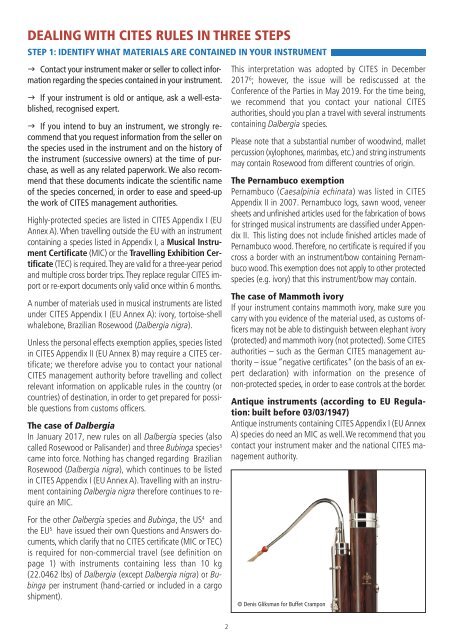fim-cites-handbook-final
Create successful ePaper yourself
Turn your PDF publications into a flip-book with our unique Google optimized e-Paper software.
DEALING WITH CITES RULES IN THREE STEPS<br />
STEP 1: IDENTIFY WHAT MATERIALS ARE CONTAINED IN YOUR INSTRUMENT<br />
Contact your instrument maker or seller to collect information<br />
regarding the species contained in your instrument.<br />
If your instrument is old or antique, ask a well-established,<br />
recognised expert.<br />
If you intend to buy an instrument, we strongly recommend<br />
that you request information from the seller on<br />
the species used in the instrument and on the history of<br />
the instrument (successive owners) at the time of purchase,<br />
as well as any related paperwork. We also recommend<br />
that these documents indicate the scientific name<br />
of the species concerned, in order to ease and speed-up<br />
the work of CITES management authorities.<br />
Highly-protected species are listed in CITES Appendix I (EU<br />
Annex A). When travelling outside the EU with an instrument<br />
containing a species listed in Appendix I, a Musical Instrument<br />
Certificate (MIC) or the Travelling Exhibition Certificate<br />
(TEC) is required. They are valid for a three-year period<br />
and multiple cross border trips. They replace regular CITES import<br />
or re-export documents only valid once within 6 months.<br />
A number of materials used in musical instruments are listed<br />
under CITES Appendix I (EU Annex A): ivory, tortoise-shell<br />
whalebone, Brazilian Rosewood (Dalbergia nigra).<br />
Unless the personal effects exemption applies, species listed<br />
in CITES Appendix II (EU Annex B) may require a CITES certificate;<br />
we therefore advise you to contact your national<br />
CITES management authority before travelling and collect<br />
relevant information on applicable rules in the country (or<br />
countries) of destination, in order to get prepared for possible<br />
questions from customs officers.<br />
The case of Dalbergia<br />
In January 2017, new rules on all Dalbergia species (also<br />
called Rosewood or Palisander) and three Bubinga species 3<br />
came into force. Nothing has changed regarding Brazilian<br />
Rosewood (Dalbergia nigra), which continues to be listed<br />
in CITES Appendix I (EU Annex A). Travelling with an instrument<br />
containing Dalbergia nigra therefore continues to require<br />
an MIC.<br />
This interpretation was adopted by CITES in December<br />
2017 6 ; however, the issue will be rediscussed at the<br />
Conference of the Parties in May 2019. For the time being,<br />
we recommend that you contact your national CITES<br />
authorities, should you plan a travel with several instruments<br />
containing Dalbergia species.<br />
Please note that a substantial number of woodwind, mallet<br />
percussion (xylophones, marimbas, etc.) and string instruments<br />
may contain Rosewood from different countries of origin.<br />
The Pernambuco exemption<br />
Pernambuco (Caesalpinia echinata) was listed in CITES<br />
Appendix II in 2007. Pernambuco logs, sawn wood, veneer<br />
sheets and unfinished articles used for the fabrication of bows<br />
for stringed musical instruments are classified under Appendix<br />
II. This listing does not include finished articles made of<br />
Pernambuco wood. Therefore, no certificate is required if you<br />
cross a border with an instrument/bow containing Pernambuco<br />
wood. This exemption does not apply to other protected<br />
species (e.g. ivory) that this instrument/bow may contain.<br />
The case of Mammoth ivory<br />
If your instrument contains mammoth ivory, make sure you<br />
carry with you evidence of the material used, as customs officers<br />
may not be able to distinguish between elephant ivory<br />
(protected) and mammoth ivory (not protected). Some CITES<br />
authorities – such as the German CITES management authority<br />
– issue “negative certificates” (on the basis of an expert<br />
declaration) with information on the presence of<br />
non-protected species, in order to ease controls at the border.<br />
Antique instruments (according to EU Regulation:<br />
built before 03/03/1947)<br />
Antique instruments containing CITES Appendix I (EU Annex<br />
A) species do need an MIC as well. We recommend that you<br />
contact your instrument maker and the national CITES management<br />
authority.<br />
For the other Dalbergia species and Bubinga, the US 4 and<br />
the EU 5 have issued their own Questions and Answers documents,<br />
which clarify that no CITES certificate (MIC or TEC)<br />
is required for non-commercial travel (see definition on<br />
page 1) with instruments containing less than 10 kg<br />
(22.0462 lbs) of Dalbergia (except Dalbergia nigra) or Bubinga<br />
per instrument (hand-carried or included in a cargo<br />
shipment).<br />
© Denis Gliksman for Buffet Crampon<br />
2


